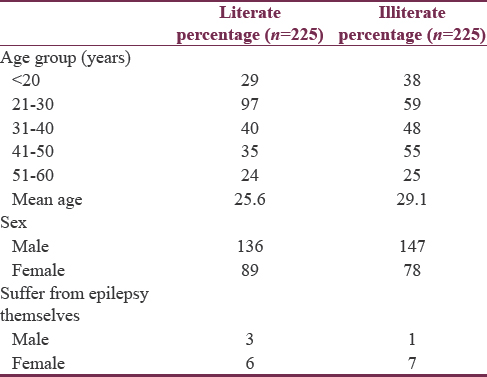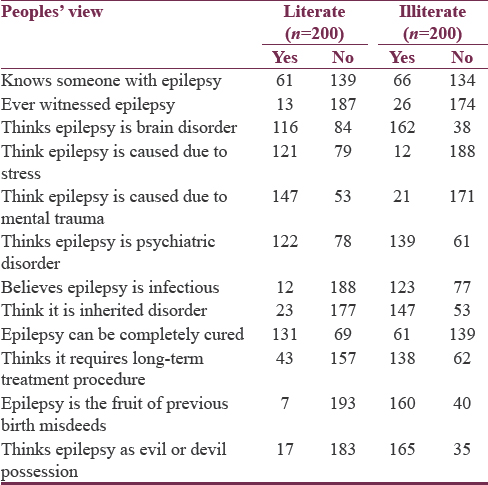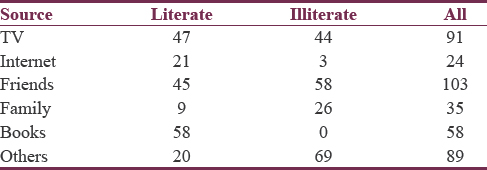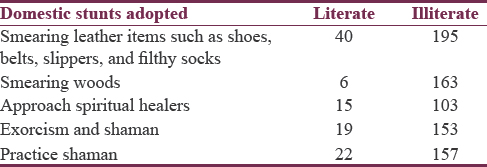Translate this page into:
Myths and Superstition about Epilepsy: A Study from North India
Address for correspondence: Prof. Rameshwar Nath Chaurasia, Department of Neurology, Institute of Medical Sciences, Banaras Hindu University, Varanasi - 221 005, Uttar Pradesh, India. E-mail: goforrameshwar@gmail.com
This is an open access journal, and articles are distributed under the terms of the Creative Commons Attribution-NonCommercial-ShareAlike 4.0 License, which allows others to remix, tweak, and build upon the work non-commercially, as long as appropriate credit is given and the new creations are licensed under the identical terms.
This article was originally published by Medknow Publications & Media Pvt Ltd and was migrated to Scientific Scholar after the change of Publisher.
Abstract
Background:
Epilepsy is a treatable chronic neurological disorder which is often linked to supernatural activities, due to lack of knowledge and awareness among the common people. The beliefs that outbreak of epilepsy as an unnatural or supernatural activities can be most frequently seen in rural population. One cannot say that the perception of urban populace is different from that of rural populace, but yes, they do differ at some extent.
Objective:
Knowledge, superstition, and myth toward epilepsy in North India.
Methods:
This is a questionnaire-based study (12 questions) conducted in neurology outpatient department of Banaras Hindu University, visited by more than hundreds of people from different province of northern India. This survey was also conducted in nearby areas of holy city Varanasi. People belonging to different socioeconomic background and educational level were surveyed to know their view regarding epilepsy.
Results:
In this survey conducted by our team, we came to the truth that urban population do consider epilepsy as an unnatural phenomenon and adopted different treatment tactics as given in this article.
Conclusion:
There is the urgent need of creating awareness among the common people through different means such as newspaper, television, organizing health camps, and training local health practitioners for epilepsy management.
Keywords
Epilepsy
exorcism
knowledge
shaman
INTRODUCTION
India is a large south Asian country with billions of people belonging to different caste and creed with different social and cultural background and socioeconomic class. Here, people have different views, beliefs, perception, and knowledge about different situations. One of the major problems which are being discussed in this article is related to the knowledge, awareness, and beliefs of people regarding epilepsy. Epilepsy is one of the most common chronic noncommunicable brain disorders characterized by recurrent seizures, sometimes followed by unconsciousness and involuntary bowel and bladder movement. It can be treated either by medicine or by surgery.[1] According to World Health organization, around 0.5% of the world is bearing the burden of the disease. More than 85% of epilepsy cases are reported in low-income countries like India. About 95% of the epileptic patients are not able to get the adequate treatment either due to the lack of medical facilities or due to the unawareness about the disease treatment as quoted by Times of India, New Delhi edition. Poor availability of antiepileptic drugs may also be one of the factors of disease remaining untreated. Epilepsy has been a part of social stigma in India because of which people are stuck to superstitious beliefs. They would rather prefer approaching faith healer, shamans’, black magic practitioners, and exorcists instead of an expert physician/neurophysician.[23] Although the facility of modern medicine is available almost in every part of the country, only 60% of the patients from urban areas and 10% patients from the rural areas approach clinicians for their treatment,[4] and rest of the patients undergoes spiritual and witchcraft practices. Some people adopt both medical and spiritual mode of treatment, and by doing this, they achieve mental satisfaction as they believe that spiritualism acts as a booster.[56789] Epilepsy is considered as a curse of bad evils, and thus, the epileptic patients are abandoned and discriminated from the society. Epileptic patients and their families undergo pressure of social fear, misunderstanding, social discrimination and dishonor, disturbed personal and professional life.[1] The major factor driving superstitious beliefs regarding epilepsy are illiteracy, low standard of life, socioeconomic backwardness, treatment gap, religious dogma ruling the mind of the people, and lack of proper medical facilities.[10]
METHODS
A questionnaire survey was performed to examine the attitude and knowledge of common people regarding epilepsy. These people were patients and their attendants who came to neurology outpatient department (OPD) of Institute of Medical Sciences (Banaras Hindu University). Patients attending OPD were from North Indian province of Uttar Pradesh including Varanasi city and Bihar. We aimed at people with different socioeconomic conditions and educational background. A total of 450 people were included in this survey, among which only 400 knew about epilepsy. Among this 400, 200 were literates (senior secondary and above) and 200 were illiterates.
A questionnaire was developed by neurology experts to know familiarity and knowledge of people about epilepsy and also the attitude of people for epileptic patients. Most of the questions were Yes/No type and others were preset answers to tick. A short introduction of the survey was given to the people to ensure their voluntary participation in the survey after taking their consent. It took around almost a week to complete the questionnaire.
The questions formulated are as given below:
-
Whether the person have heard of epilepsy and know someone with epilepsy
-
Whether the person ever witnessed epilepsy
-
Whether he/she thinks epilepsy is none other than the disorder of the brain
-
Whether epilepsy is a psychiatric disorder
-
Can epilepsy be genetically inherited from parents to offspring
-
Whether epilepsy is an infectious disease
-
Is the treatment of epilepsy possible, and if yes, then would it be a lifelong treatment
-
What step should one take in case he/she finds anyone with epileptic fits
-
Whether people think that epilepsy is the impact of bad/evil spirits
-
Whether the diet of a person plays major role in epilepsy
-
Can epilepsy could be treated by the exorcists and spiritual healers
-
Whether epilepsy is the result of the past life sins.
RESULTS
Demographic data of the participants
During the survey, 450 people actively participated in the study. People included in the study were from North India and Nepal. People of all age group were included in the study. Out of 450 people, 283 were males and 167 were females. They belonged to different socioeconomic status. People with different educational background, i.e., from middle class to postgraduate were included in this study [Table 1].

Familiarity with epilepsy
Out of the 450 respondents, 400 people (88%) were aware of epilepsy. Sixty-one among 200 literates, i.e., 30.5% and 66 among 200 illiterates, i.e., 33% knew a person with epilepsy. People were asked from where they came to know about the disease and opted from the predefined options in the questionnaire. It was found that most of the people came to know about epilepsy through friends and television. The number of the people who witnessed seizure was higher among illiterates (26/200), i.e., 13% than literates (13/200), i.e., 6.5%.
Knowledge of epilepsy
A set of few questions in the questionnaire which was to be answered in simple yes or no was formulated to test the knowledge of the common people about epilepsy. A significant variation was found in the views of literates and illiterates which are shown in Table 2. It was found that 116/200 (58%) literates and 162/200 (81%) illiterates believe that epilepsy is a brain disorder. 121/200 (60.5%) literates and 12/200 (6%) illiterates say that this is caused due to stress. 147/200 (73.5%) people among literates think that epilepsy is caused due to mental trauma and 21/200 (10.5%) of the literates think the same. 122/200 (61%) literates and 139/200 (69.5%) illiterates consider epilepsy as psychiatric disorder. 12/200 (6%) and 123/200 (62%) literates and illiterates, respectively, think epilepsy as an infectious disease. 23/200 (11.5%) literates and 147/202 (73.5%) illiterates think that it is genetically inherited. 131/200 (65.5%) literates think that epilepsy can be completely cured and 61/200 (30.5%) illiterates think the same. 43/200 (21.5%) literates and 138/200 (69%) illiterates say that this treatment requires long treatment procedure. 7/200 (3.5%) literate population consider epilepsy as a result of previous misdeeds and 160/200 (80%) people among illiterates consider the same. This result was much surprising because in this era of modern medicine and technology, still superstitious believes prevail among large populace. 165/200 (82.5%) illiterates stated that epilepsy is the result of devil possession and very few 17/200 (8.5%) literates think the same. Table 3 shows the various means from which the respondents came to know about epilepsy.


Treatment of epilepsy
We came to know about various treatment tactics adopted by different people. Many people among the illiterates suggested various self-innovative treatment methods and path of spiritualism to treat epilepsy. Very few were there among the literate people who believed on domestic stunts such as sniffing leather objects and superstitious tantrums. Few domestic stunts which adopted by the respondents are given in Table 4. The availability of modern medicine and technology for the treatment of epilepsy was known by very few. These people believed in taking epileptic patients to hospital and consulting epilepsy specialist.

DISCUSSION
With the advancement of science and technology, epilepsy is no more a grievous disorder, but still, in most of the part of our country, it is thought to be untreatable. It is unfortunate that being one of the leading developing countries of the world, Indian population is still choosing the path of evil and spiritual practices as an easy and acceptable treatment.[11] Due to lack of knowledge and awareness, people are deprived of medical facility and are drowning in the swamp of superstition.[1213] Superstitions practices are most prevalent among the epileptic patient in rural areas where people approach spiritual healers and shamans to get rid of the problem. Shamans are those who are believed to be blessed by divine power and are directly connected with God almighty.[14] People have their own set of categories of epilepsy such as epilepsy due to altitude, fire, and water. They have self-innovative epilepsy treatment methods such as smearing leather items such as shoes, belts, and filthy socks. Many people suggest that epileptic patients should avoid going near fire, deep water, and altitude. Methods such as practising witchcraft, donning amulets, sorcery, and application of divine ash (Bhabhut) are also adopted by some people. Epileptic patients are made to suffer a lot and are socially discriminated.[1] Most important issue is to bring balance between faith, spiritualism, and science.
CONCLUSION
Since prehistoric era, human being has been practising multiple self-innovative techniques for management of unique disorder. Epilepsy have been one such disorder where mankind has performed lots of new self-research, for example, trephine has been one of the treatments of epilepsy in prehistoric era later in years to come in 16th and 17th century; there are evidences that management of epilepsy has been done by witchcraft, practising exorcism, evil treatment by burning in fire, by time and heating above fire by sacrificing animals. It is hard enough to make out what made to promote this theory of super natural practices which are still prevalent in the society for the treatment of epilepsy. Availability of the modern medical facilities in remote and isolated areas due to difficulty of assessing transport facility is an emerging challenge. Hence, we conclude that we need to work hard on curbing these supernatural practices in epilepsy management by health awareness promotion and making people educated and self-employed.
Financial support and sponsorship
Nil.
Conflicts of interest
There are no conflicts of interest.
REFERENCES
- World Health Organization. Disease and Injury Regional Estimates for 2004. Geneva, World Health Organization. Available from: http://www.who.int/healthinfo/global_burden_disease/estimates_regional/en/index.html
- [Google Scholar]
- Help seeking behaviour of psychiatric patients before seeking care at a mental hospital. Int J Soc Psychiatry. 2001;47:71-8.
- [Google Scholar]
- Help-seeking behavior of patients with mental health problems visiting a tertiary care center in North India. Indian J Psychiatry. 2011;53:234-8.
- [Google Scholar]
- A meta-analysis of the relationship between spirituality and quality of life. Soc Indic Res. 2005;72:15388.
- [Google Scholar]
- Psychogenic seizures in an espiritismo context: The role of culturally sensitive psychotherapy. Psychother Theory Res Pract Train. 2005;42:613.
- [Google Scholar]
- Research on religion, spirituality, and mental health: A review. Can J Psychiatry. 2009;54:283-91.
- [Google Scholar]
- Religiousness affects mental health, pain and quality of life in older people in an outpatient rehabilitation setting. J Rehabil Med. 2011;43:316-22.
- [Google Scholar]
- Complementary Spiritist therapy: Systematic review of scientific evidence. Evid Based Complement Alternat Med 2011 2011 835945
- [Google Scholar]
- Epilepsy in India II: Impact, burden, and need for a multisectoral public health response. Ann Indian Acad Neurol. 2015;18:369-81.
- [Google Scholar]
- Experiences of religious healing in psychiatric patients in South India. Soc Psychiatry Psychiatr Epidemiol. 1997;32:215-21.
- [Google Scholar]
- Psychosocial, demographic, and treatment-seeking strategic behavior, including faith healing practices, among patients with epilepsy in Northwest India. Epilepsy Behav. 2008;13:323-32.
- [Google Scholar]
- Shamans and priest among the Plain Indians. In: Lessa WA, Vogt EZ, eds. Reader in Comparative Religion. Evanston, IN: Row, Peterson; 1958. p. :411-3.
- [Google Scholar]






